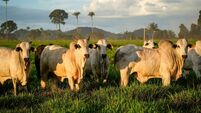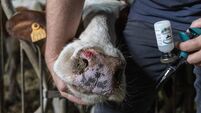Baled silage, the sensible choice
Plans should now be underway for silage on most farms. A silage plan should include an estimate of how much silage will be needed for the coming winter. The stocking numbers will decide how many hectares will need to be closed for first and second cut silage. Energy requirements will differ for example livestock that are lactating or pregnant will have higher energy needs.
Convenience and cost are two reasons why baled silage has become so popular in Ireland. Baled silage is a good choice because the costs of baling, wrapping and transport are calculated per bale and there is less waste when making small quantities of high quality silage when compared to conventional pit silage. Bales can be stored where they will be needed at feed out and they can be used as supplements to diet where only a small number of stock is housed or during periods of wet weather such as last summer. Baled silage can be made with surplus grass and as an alternative to hay where conditions do not allow for the grass to sufficiently dry out.
The quality of the silage is largely due to the grass it is made with. Grass that has been recently reseeded with ryegrass will produce digestible silage and should produce a high yield. Leafy grass will produce better results than an older stemmy grass so cutting at the correct time is also important. The pH value of the silage is also important this should be low (i.e. not acidic) and this is usually achieved by wilting the grass before wrapping the bales.
On many dairy farms, there are opportunities to take out early surpluses as high quality bales, especially this year due to favourable grass growth.
Removing surplus grass in this way maintains grass quality, which is critical to maintaining milk solids production throughout the summer months.
Taking surpluses out at low covers, such as 1,500 to 2,000 kg of dry matter per hectare, results in really high quality baled material.
Typically, such silage has a DMD of 78 to 80%, and a dry matter content of 30% plus. Taking out surpluses as they arise allows for paddock to start growing immediately, so there should be no shortage of grass for the next rotation, and grass quality will be excellent.
These bales are not cheap to make. But on a cost per unit of energy basis, they are very competitive with concentrates at current prices.
WILTING eliminates the need for additives to ensure preservation and it also reduces the problem of effluent. The wilting also means that baled silage usually has a higher dry matter (DM) content than conventional silage. When planning your silage cut wait until the dew has evaporated to help with the wilt. Monitor the weather forecasts and try to mow and wilt during a spell of dry, sunny weather. When wilting set a target of about 30% to 35% dry matter (DM). That is the best stage at which to bale. Wilting reduces bale weight which helps when making and storing bales and it avoids the need for preservative-type additives. It also reduces the number of bales, reducing cost.
When planning your wilt you should not leave the crop on the ground for more than one night. If the grass crops are heavy or drying is poor use spreading or tedding techniques. Spreading maximises the quantity of grass exposed to the sun and air. Tedding or turning redistributes grass and exposes wetter portions to these drying elements. The extent of ground cover following swath treatment has the biggest effect on drying rate. Thin grass layers dry quickly.
Wrapping the silage bales to keep them airtight is a critical part of the silage making process.
Dense well shaped bales are easier to wrap and subsequently to handle and store. Balers fitted with fixed knife choppers can usually squeeze an additional eight per cent to 15% more grass into a bale, depending on factors such as the number and sharpness of the knives.
Ideally bring the bales to their site of storage and wrap them there. This can help significantly reduce the opportunity for damage to the plastic film. When baling, adjust the bale density setting to the maximum allowable position and drive the tractor in such a manner so as to provide an even and balanced flow of grass into the bale chamber.
Wrapping plastic film should be done in accordance with the wrapper and plastic manufacturer’s recommendations. The preservation of the silage depends on the film staying intact and maintaining an airtight environment for the bale. The film needs to be of good quality and applied properly. The wrap should be applied 4- 6 times around the bale. During wrapping itself, count the number of wrapper turntable revolutions to ensure enough plastic film is being applied. The correct rate of stretch is also important as some newer thin films should not be stretched as tightly.
Move the wrapped bales to the storage area immediately after wrapping where possible. Leaving the bales more than a couple of hours will mean that bale contents can settle and they will be harder to move without damaging the airtight seal. Ideally you should wrap at the site of storage but if you do have to move bales inspect the equipment you will be using to handle bales and make sure there are no sharp or damaging edges. If film is damaged repair it immediately. Any handling of the bales must ensure that the wrap is not damaged. The potential of tears in the wrap from pests such as birds and rats is also a problem that should be guarded against. All damage should be repaired immediately to avoid spoilage.
Storage conditions should be chosen to avoid any damage to bales and also to facilitate feeding the silage. Damage from birds often happens when the bales have just been wrapped and before they are moved to the storage site.
If bales contain unwilted grass they will produce effluent and they should be stored in a place where the effluent can be collected. Wilted bales can be stacked and should be stored on a smooth hard surface. Covering bales with netting can prevent damage from pests. Fencing may also protect from rodents and painting the bales can scare away birds. The bales should be inspected regularly to ensure that any damage is caught early and immediately repaired.












